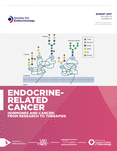mTOR inhibitors response and mTOR pathway in pancreatic neuroendocrine tumors
- Simona Falletta1,
- Stefano Partelli2,
- Corrado Rubini3,
- Dominik Nann4,
- Andrea Doria3,
- Ilaria Marinoni4,
- Vanessa Polenta2,
- Carmelina Di Pasquale1,
- Ettore degli Uberti1,
- Aurel Perren4,
- Massimo Falconi2 and
- Maria Chiara Zatelli1⇑
- 1Department of Medical Science, Section of Endocrinology and Internal Medicine, University of Ferrara, Ferrara, Italy
- 2Pancreatic Surgery Unit, Pancreas Translational and Research Institute, San Raffaele Hospital, Vita-Salute San Raffaele University, Milan, Italy
- 3Department of Biomedical Sciences and Public Health, Polytechnic University of Marche, Ancona, Italy
- 4Institut fur Pathologie, University of Bern, Bern, Switzerland
- Correspondence should be addressed to M C Zatelli; Email: ztlmch{at}unife.it
-
Figure 1
Effects of Everolimus and IGF1 on P-NET primary cultures. P-NET primary cultures were incubated in 96-well plates for 48 h in a culture medium supplemented with 100 nM Everolimus with (black bars) or without 100 nM IGF1 (white bars); control cells were treated with a vehicle solution. Cell viability and caspase activation of each primary culture were measured as a luminescent signal. According to the response to Everolimus in terms of cell viability inhibition, the samples were divided into ‘responder’ (6 samples) (A) and ‘non-responder’ (14 samples) (B). Data from P-NET primary cultures were evaluated independently with six replicates each, and expressed as the mean value ± s.e.m. percent cell viability inhibition vs untreated control cells (upper panels) or as the mean value ± s.e.m. percent caspase activation vs untreated control cells (lower panels). *P < 0.05 and ***P < 0.001 vs untreated control cells. #P < 0.05 and ###P < 0.001 vs cells treated with Everolimus alone.
-
Figure 2
IGF1/mTOR signaling pathway expression in P-NET tissues. Total proteins were isolated from 20 P-NET tissues and AlphaScreen analysis for p-IGF1 R (A), p-AKT (B), p-mTOR (C) and p-4EBP1 (D) expression in the pooled P-NET R and in the pooled P-NET NR tissues was performed, as described in the ‘Materials and methods’ section. Values are expressed after normalization against glyceraldehyde-3-phosphate dehydrogenase (GAPDH) as AlphaScreen signal (counts). **P < 0.02 and ***P < 0.001 vs P-NET R.
-
Figure 4
Association between p-AKT expression and clinical outcomes. (A) Immunohistochemical expression of p-AKT in a non-functioning G3 P-NET (T3N1M1), sensitive to Everolimus after surgery, defined as P-NET-R in vitro. (B) Immunohistochemical expression of p-AKT in a non-functioning G2 P-NET (T3N1M1), resistant to Everolimus after surgery and defined as P-NET-NR in vitro.
- © 2016 Society for Endocrinology












